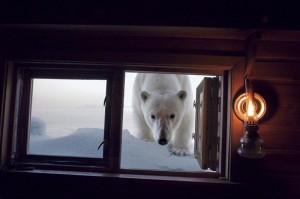State of the Art Displays at The Annenberg Space for Photography’s new show make for Stunning Viewing —
If you grew up poring through the pages of National Geographic, you will appreciate learning that the current Editor-in-Chief of the renowned publication grew up doing exactly the same thing. Chris Johns became a successful newspaper photographer, ultimately shooting in Africa for decades, and in 2005 he became the first photographer to be put in charge of the esteemed publication.
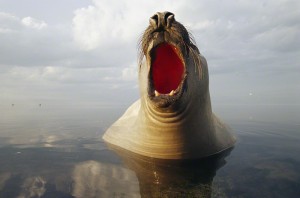
Point Henry Victoria, Australia 2004 by Jason Edwards, National Geographic. A Southern Elephant Seal barks loudly as it breaks the water’s surface.
Proving two things; first, that it’s really all about the pictures. And second, that a passion curated from a young age can lead to a rewarding career. So, if your kids have any affection for photography — and we suspect those little Instagrammers do — bring them to The Power of Photography: National Geographic 125 Years at our favorite place to view pictures – The Annenberg Space for Photography. The show opens on Saturday, October 26 and runs through April 27, 2014.
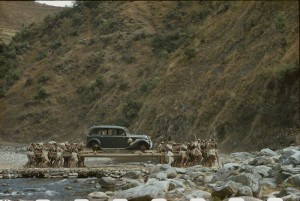
Nepal, 1948 by Volkmar K. Wentzel National Geographic
Instead of cars carrying workers, Nepal has workers carrying cars on the trail from Katmandu.
In a state-of-the-art gallery — with 4K resolution screens built specifically to show off 501 carefully selected images — you will visit all corners of the globe, marveling in the wonders that 125 years of spectacularly shot and curated images can offer.
A passion for the environment and species of the planet. Glimpses into cultures and worlds we never knew existed. Sympathetic portraits. Stirring images from the front lines of conflict around the globe. And, images of our own country that open our eyes to something we didn’t previously know.
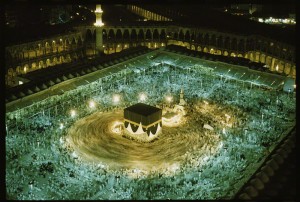
Saudi Arabia 1965 by Thomas J. Abercrombie, National Geographic. Pilgrims Circle the Kabba in Mecca.
To expand our minds, to spread compassion for human beings and the planet. To inspire travel and social change – these are the lofty ambitions that fuel the work of the men and women who pick up their cameras and share what they see and learn in their travels.
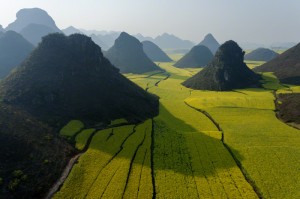
Luoping, China 2007 by George Steinmetz, National Geographic. Views of small limestone hills punctuating privately owned fields of rape plants in flower.
After years of paging through the magazine, I never tire of it. The National Geographic website is equally intriguing, robust with facts about everything you can imagine (and, incidentally, a great resource for kids doing research projects). We particularly love paging backwards through the Photo of the Day column.
The editors of the magazine had a real challenge to mount this show. It can’t have been easy to select 500 “best images” from decades of great shots.
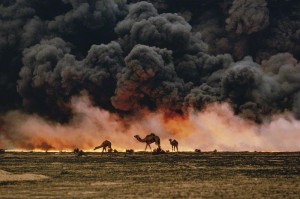
Kuwait, 1991 by Steve McCurry, National Geographic. In the wake of the Gulf War, camels search for untainted shrubs and water in the burning oil fields.
And then – how to display them all!? They lucked out in their partnership with the Annenberg Space for Photography, who designed massive, high-resolution screens and dug them into the walls of their gallery. Each set of screens shows off hundreds of images. As National Geographic’s Director of Photography Sarah Leen explained, the screens around the galleries are a solution to the limitations of print. Instead of hanging hundreds of images in individual frames, viewers can stand before the screens to watch photos scroll (some of the slide shows last as long as 16 minutes). This novel design allows the curatorial staff to pair images that comment upon each other and offer a more fulsome, narrative effect. Every empty space of wall is also covered with a wallpaper made up of all 501 images, as well, which creates a colorful, pulsating effect.
All in all, it’s a very satisfying experience – for the eyes, and for the soul.
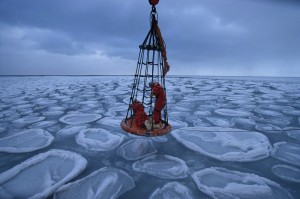
Southern Ocean, Antarctica 1996 by Maria Stenzel, National Geographic. Suspended above winter sea ice, researchers study an ecosystem resistant to easy observation.
Take time to watch the documentary film projected in the central room of the gallery. It was produced for the show, and chronicles the passions of the photographers behind the work. Ultimately, the film offers a message that images do make a difference — that change is often produced when powerful images are used effectively to move passions and minds. The Annenberg also hosts a popular series of lectures with visiting photographers. Click here for more information on the Iris Nights Lecture Series.
The tough subject matter of this film may be difficult for younger kids, who may like a series of short films (under 2 minutes) shown in the back hall of the space (by the restrooms!). We loved watching a cheetah’s face through a field slowed down to show the intricate musculature of this speed machine.

Twins Day Festival, Twinsburg Ohio 2011 by Martin Schoeller, National Geographic. Marta: the 15 year-old twins want to go to the same university and sing opera.

Twins Day Festival, Twinsburg Ohio 2022 by Martin Schoeller, National Geographic. Emma: they both like to draw as well but have a different approach to their art.

